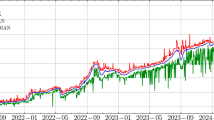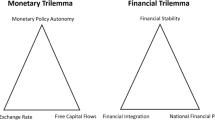Abstract
We develop an empirical model of heterogeneous agents to study the dynamics of the European sovereign bonds market. Agents make use of different information from the CDS market and historical price movements of the sovereign bonds for their trading decisions. Subject to the perceived sovereign risk, agents exhibit changing trading behaviors in high-risk periods and tranquil times. To compare the ability of our model to identify crises periods, we also run a generalized sup ADF test as suggested in Phillips et al. (Int Econ Rev 56(4):1043–1078, 2015). Our results indicate that the smooth transition regression framework may provide additional valuable information regarding the timing of crisis events.




Similar content being viewed by others
Notes
For the four level time series, \(\mathrm{BS}_\mathrm{Ge}\), \(\mathrm{BS}_\mathrm{Gr}\), \(\mathrm{CDS}_\mathrm{Ge}\) and \(\mathrm{CDS}_\mathrm{Gr}\), unit root tests already suggest that all these time series are I(1) processes.
While the extant literature mainly uses I(0) process variables as transition variables such that spurious regressions could be avoided in the linearity test, Lundbergh et al. (2003) propose a two-regime model with a non-stationary transition variable. Battaglia and Protopapas (2011, 2012) propose a procedure based on genetic algorithms to evaluate time-varying multi-regimes models with non-stationary transition variables and apply in the investigation of global warming. In our case, the German and Greek CDS spreads are I(1) processes. We verify that the residuals of each linearity regression are I(0) processes, and therefore, the concern is eased for the spurious regression in the linearity test.
Given the high persistence of \(\mathrm{ERR}_{i,t}\) statements about statistical significance of the estimated coefficients have to be taken with caution, since t-statistics may be unreliable, see, for instance, Phillips and Lee (2013).
References
Arghyrou MG, Kontonikas A (2012) The emu sovereign-debt crisis: fundamentals, expectations and contagion. J Int Financ Mark Inst Money 22(4):658–677
Badaoui S, Cathcart L, El-Jahel L (2013) Do sovereign credit default swaps represent a clean measure of sovereign default risk? A factor model approach. J Bank Finance 37(7):2392–2407
Battaglia F, Protopapas M (2011) Time-varying multi-regime models fitting by genetic algorithms. J Time Ser Anal 32(3):237–252
Battaglia F, Protopapas M (2012) An analysis of global warming in the alpine region based on nonlinear nonstationary time series models. Stat Methods Appl 21(3):315–334
Beirne J, Fratzscher M (2013) The pricing of sovereign risk and contagion during the European sovereign debt crisis. J Int Money Finance 34:60–82
Blommestein, HJ, Eijffinger SCW, Qian Z (2012) Animal spirits in the euro area sovereign cds market (2012). CEPR Discussion Paper No. DP9092. SSRN: https://ssrn.com/abstract=2153542
Caspi I (2013) Rtadf: testing for bubbles with eviews. MPRA Paper 58791, University Library of Munich, Germany, revised 06 Sep 2014
Chen Z, Huang W, Zheng H (2018) Estimating heterogeneous agents behavior in a two-market financial system. J Econ Interact Coord 13(3):491–510
Chiarella C, ter Ellen S, He X-Z, Wu E (2015) Fear or fundamentals? Heterogeneous beliefs in the European sovereign CDS market. J Empir Finance 32:19–34
Connolly R, Stivers C, Sun L (2005) Stock market uncertainty and the stock-bond return relation. J Financ Quant Anal 40(1):161–194
De Jong E, Verschoor WF, Zwinkels RC (2009) Behavioural heterogeneity and shift-contagion: evidence from the Asian crisis. J Econ Dyn Control 33(11):1929–1944
Dieci R, Westerhoff F (2010) Heterogeneous speculators, endogenous fluctuations and interacting markets: a model of stock prices and exchange rates. J Econ Dyn Control 34(4):743–764
Duffie D (1999) Credit swap valuation. Financ Anal J 55(1):73–87
Escribano Á, Jordá O (2001) Testing nonlinearity: decision rules for selecting between logistic and exponential star models. Span Econ Rev 3(3):193–209
Frijns B, Zwinkels RC (2016) Speculation in European sovereign debt markets. SSRN: https://ssrn.com/abstract=2725975 or https://doi.org/10.2139/ssrn.2725975
Ghosh AR, Ostry JD, Qureshi MS (2013) Fiscal space and sovereign risk pricing in a currency union. J Int Money Finance 34:131–163
Homm U, Breitung J (2012) Testing for speculative bubbles in stock markets: a comparison of alternative methods. J Financ Econom 10(1):198–231
Huang W, Chen Z (2014) Modeling regional linkage of financial markets. J Econ Behav Organ 99:18–31
Jaramillo L, Weber A (2013) Bond yields in emerging economies: it matters what state you are in. Emerg Markets Rev 17:169–185
Leppin JS, Reitz S (2016) The role of a changing market environment for credit default swap pricing. Int J Finance Econ 21(3):209–223
Lof M (2012) Heterogeneity in stock prices: a STAR model with multivariate transition function. J Econ Dyn Control 36(12):1845–1854
Lundbergh S, Teräsvirta T (1998) Modeling economic high frequency time series with star garch models. Stockholm School of Economics WP No. 291
Lundbergh S, Teräsvirta T, van Dijk D (2003) Time-varying smooth transition autoregressive models. J Bus Econ Stat 21(1):104–121
Palladini G, Portes R (2011) Sovereign CDS and bond pricing dynamics in the euro-area. Working Paper 17586, National Bureau of Economic Research
Phillips PC, Lee JH (2013) Predictive regression under various degrees of persistence and robust long-horizon regression. J Econom 177(2):250–264
Phillips PC, Shi S-P, Yu J (2015) Testing for multiple bubbles: historical episodes of exuberance and collapse in the s&p 500. Int Econ Rev 56(4):1043–1078
Reitz S, Westerhoff F (2007) Commodity price cycles and heterogeneous speculators: a star-garch model. Empir Econ 33(2):231–244
Reitz S, Rülke J-C, Stadtmann G (2012) Nonlinear expectations in speculative markets—evidence from the ecb survey of professional forecasters. J Econ Dyn Control 36(9):1349–1363
Schmitt N, Westerhoff F (2014) Speculative behavior and the dynamics of interacting stock markets. J Econ Dyn Control 45:262–288
Teräsvirta T (1994) Specification, estimation, and evaluation of smooth transition autoregressive models. J Am Stat Assoc 89(425):208–218
Teräsvirta T (1998) Modelling economic relationships with smooth transition regressions. In: Giles D, Ullah A (eds) Handbook of applied economic statistics. Marcel Dekker, New York, pp 507–522
Westerhoff FH, Dieci R (2006) The effectiveness of Keynes–Tobin transaction taxes when heterogeneous agents can trade in different markets: a behavioral finance approach. J Econ Dyn Control 30(2):293–322
Wu E, Erdem M, Kalotychou E, Remolona E (2016) The anatomy of sovereign risk contagion. J Int Money Finance 69:264–286
Xiong W, Yan H (2010) Heterogeneous expectations and bond markets. Rev Financ Stud 23(4):1433–1466
Acknowledgements
We thank the anonymous reviewer for extraordinary valuable comments on earlier version of this article. We are grateful of the guidance received from editor Bertrand Candelon. We also thank Donald Lien for the valuable suggestions and Annalee McWilliams for excellent research assistance. This project has received funding from the European Union’s Seventh Framework Programme for research, technological development and demonstration (Grant Agreement No. 612955), the Youth Foundation of the Humanities and Social Sciences Research of the Ministry of Education of China (Grant No. 17YJC790016) and the Natural Science Foundation of Guangdong Province, China (Grant No. 2017A030310314).
Author information
Authors and Affiliations
Corresponding author
Additional information
Publisher's Note
Springer Nature remains neutral with regard to jurisdictional claims in published maps and institutional affiliations.
Rights and permissions
About this article
Cite this article
Chen, Z., Reitz, S. Dynamics of the European sovereign bonds and the identification of crisis periods. Empir Econ 58, 2761–2781 (2020). https://doi.org/10.1007/s00181-019-01653-0
Received:
Accepted:
Published:
Issue Date:
DOI: https://doi.org/10.1007/s00181-019-01653-0




